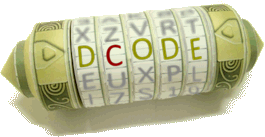Tool to make escaped or unescaped HTML code. The HTML code is able to auto-encode to display itself in HTML pages thanks to the HTML escape mechanism.
HTML Escape - dCode
Tag(s) : Internet
dCode is free and its tools are a valuable help in games, maths, geocaching, puzzles and problems to solve every day!
A suggestion ? a feedback ? a bug ? an idea ? Write to dCode!
HTML Escape
Unescape HTML
Escape HTML
Answers to Questions (FAQ)
What is HTML Escaping? (Definition)
HTML Escape (or HTML Entities Encoding) is the name given to the technique that allows you to display HTML code inside an HTML code. The basic principle is to encode the characters < and > and the apostrophe ' so that they are no longer considered as tags.
Example: < is coded <
HTML codes start with & (ampersand) and end with ; (semicolon)
What are HTML character reference names?
The HTML standard defines several hundred non-alphanumeric characters by a name, a code of a few letters.
The list was updated in February 2023 and should no longer change.
Why encoding more HTML characters?
In the emergence of HTML, character encoding standards such as UTF-8 were not yet sufficiently developed and non-ASCII characters (beyond 127 and from ISO-8859-1) were generally problematic. One solution was to encode them in HTML.
Unicode characters are coded either � where 0000 is the hexadecimal Unicode code of the character or � where 0000 is the decimal Unicode code of the character.
Example: ¤ for ¤
How to make a good html escaping?
The HTML escape strings depends on the programming language, PHP uses the functions htmlspecialchars() and htmlentities()
Source code
dCode retains ownership of the "HTML Escape" source code. Any algorithm for the "HTML Escape" algorithm, applet or snippet or script (converter, solver, encryption / decryption, encoding / decoding, ciphering / deciphering, breaker, translator), or any "HTML Escape" functions (calculate, convert, solve, decrypt / encrypt, decipher / cipher, decode / encode, translate) written in any informatic language (Python, Java, PHP, C#, Javascript, Matlab, etc.) or any database download or API access for "HTML Escape" or any other element are not public (except explicit open source licence like Creative Commons). Same with the download for offline use on PC, mobile, tablet, iPhone or Android app.
Reminder: dCode is an educational and teaching resource, accessible online for free and for everyone.
Cite dCode
The content of the page "HTML Escape" and its results may be freely copied and reused, including for commercial purposes, provided that dCode.fr is cited as the source.
Exporting the results is free and can be done simply by clicking on the export icons ⤓ (.csv or .txt format) or ⧉ (copy and paste).
To cite dCode.fr on another website, use the link:
In a scientific article or book, the recommended bibliographic citation is: HTML Escape on dCode.fr [online website], retrieved on 2025-04-16,
